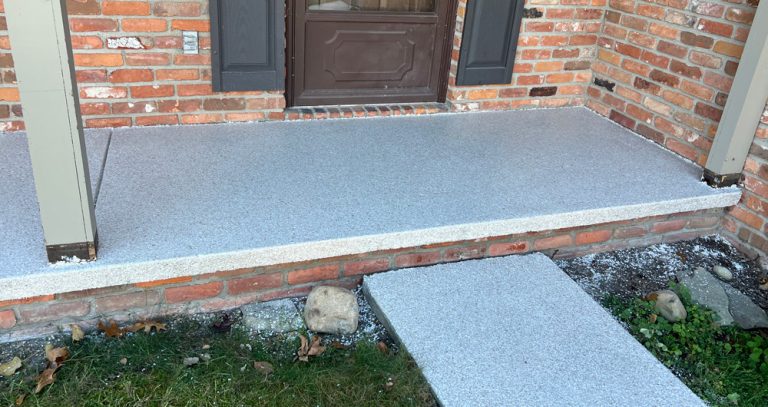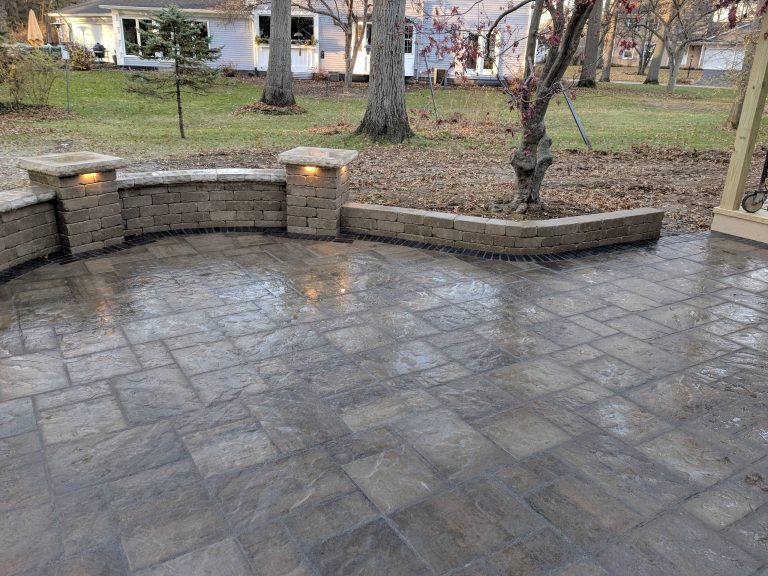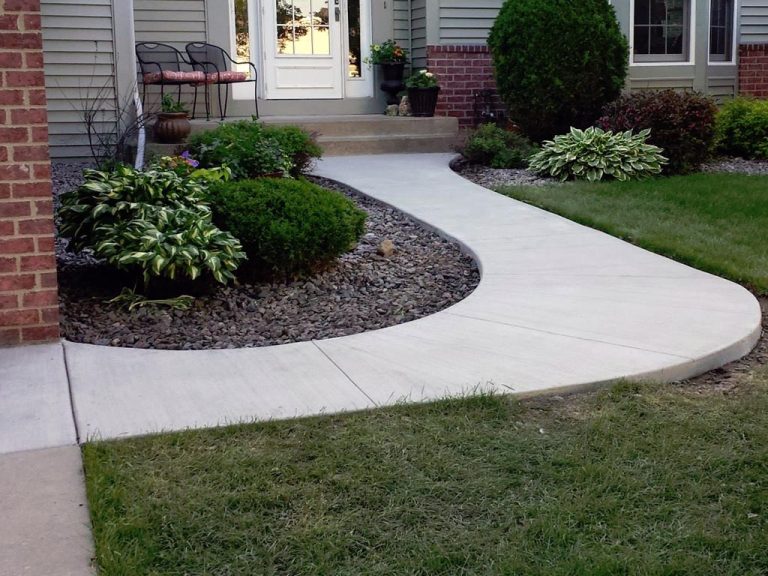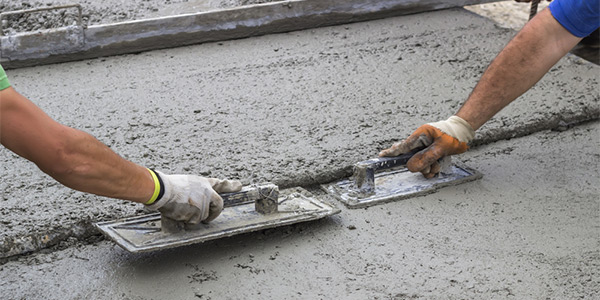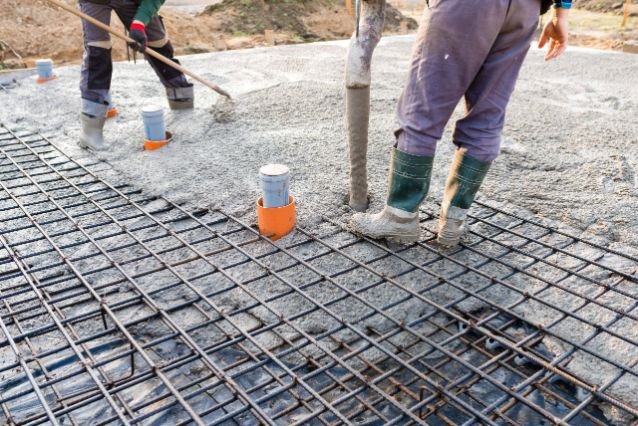When deciding on concrete for your Lansing home, the choice between stamped and regular concrete can significantly impact the appearance and functionality of your outdoor spaces. Whether planning a new driveway, patio, or walkway, understanding the differences between stamped and regular concrete is essential to making the best decision for your home.
In this guide, we’ll explore the various factors you should consider when choosing between stamped and regular concrete, from cost to maintenance to aesthetics.
Stamped Concrete vs. Regular Concrete Cost
Cost is often one of the first things homeowners consider when choosing between stamped and regular concrete. Stamped concrete is generally more expensive than regular concrete due to its intricate design and installation process.
- Stamped Concrete Costs: As of 2023, the cost of stamped concrete ranges between $8 to $18 per square foot, depending on the complexity of the design and colour variations
- . This cost includes labour, materials, and stamping patterns into the wet concrete.
- Regular Concrete Costs: Regular concrete is more affordable, typically ranging between $5 to $7 per square foot
- Regular concrete has a simpler installation process, and its lower cost makes it a more budget-friendly option for large projects.
You must consider your budget and the overall look you want when deciding. If you’re willing to invest in aesthetics, stamped concrete may be worth the extra cost, while regular concrete offers a no-frills, cost-effective solution.
Durability of Stamped Concrete
Durability is a key factor, especially for outdoor spaces like driveways and walkways that endure harsh weather conditions. Stamped and regular concrete offer strong durability but have slightly different maintenance needs.
- Stamped Concrete Durability: When properly installed and maintained, stamped concrete can last decades. However, it requires periodic sealing to prevent fading, cracking, and damage from weather exposure. Without sealing, stamped concrete can deteriorate faster.
- Regular Concrete Durability: Regular concrete is equally durable and often preferred for driveways because of its simplicity and ease of repair. It may require less sealing or maintenance than stamped concrete but can still last many years under heavy use.
Both materials are durable, but stamped concrete may require more upkeep to maintain its aesthetic appeal over time.
Maintenance of Stamped Concrete
Regarding maintenance, regular concrete has the edge in terms of simplicity. However, stamped concrete also requires care to maintain its beauty.
- Stamped Concrete Maintenance: Stamped concrete must be sealed every 2-3 years to protect it from wear and tear. This process helps prevent colour fading, cracking, and water damage. In addition, the textured surface of stamped concrete can be more difficult to clean, especially if debris and dirt accumulate in the grooves.
- Regular Concrete Maintenance: Regular concrete requires less maintenance overall. While it should still be sealed occasionally to prevent cracks and stains, its smooth surface makes it easier to clean, and repairs are more straightforward and less noticeable compared to stamped concrete
If low maintenance. is a priority, regular concrete may be the better option, especially for areas exposed to heavy traffic, like driveways.
Aesthetic Appeal of Stamped Concrete
Stamped concrete truly shines in aesthetics. With various design options available, it can transform the look of your outdoor space, mimicking materials like stone, brick, or even wood.
- Stamped Concrete Aesthetics: The appeal of stamped concrete lies in its versatility. It can be customized with different patterns, colours, and textures to match any home style, adding a touch of elegance and uniqueness. Whether you want a rustic stone look or a sleek, modern design, stamped concrete can be tailored to your aesthetic preferences.
- Regular Concrete Aesthetics: While regular concrete is functional, its appearance is plain and simple. Typically grey and flat, it doesn’t offer the same visual appeal as stamped concrete, but it does provide a clean, minimalist look that some homeowners prefer.
If you value aesthetics and want to make a statement with your home’s exterior, stamped concrete is the way to go. However, regular concrete will serve you well if you prefer a straightforward, no-nonsense design.
Stamped Concrete for Driveways
Driveways are one of the most common applications for concrete, and the choice between stamped and regular concrete will depend on your priorities.
- Stamped Concrete Driveways: Stamped concrete can elevate the look of your driveway with custom patterns and colours. However, because driveways see heavy use and exposure to weather, stamped concrete will need regular sealing to prevent cracking and fading.
- . It’s a great option if you want your driveway to enhance your home’s curb appeal.
- Regular Concrete Driveways: Regular concrete is a reliable, cost-effective option for driveways. It can withstand the weight of vehicles and is less prone to damage from weather. While it may not have the visual appeal of stamped concrete, it is a durable and practical choice.
Stamped concrete can create a stunning driveway for homeowners who prioritize appearance and are willing to invest in maintenance. Regular concrete may be better if durability and lower maintenance are more important.
Concrete Installation Process
The installation process for stamped and regular concrete differs slightly, with stamped concrete requiring more specialized labour and tools.
- Stamped Concrete Installation: Installing stamped concrete is a multi-step process that involves pouring the concrete, applying release agents to prevent the stamps from sticking, and pressing patterns into the surface. The final step involves sealing the concrete to protect it from damage.
- Regular Concrete Installation: The installation of regular concrete is more straightforward. Once the concrete is poured and levelled, it needs time to cure. While less labour-intensive than stamped concrete, the process still requires skilled professionals to ensure a smooth, durable finish.
Because stamped concrete involves more steps and specialized skills, the installation costs are typically higher than those for regular concrete.
Local Considerations: Lansing Concrete Contractors
Woryou’reith local contractors can provide several benefits if you install stamped or regular concrete in your Lansing home.
- Local Expertise: Lansing concrete contractors will have experience with the local climate and soil conditions, which can impact the longevity and performance of your concrete. They can also recommend the best type of concrete for your specific needs, whether for an aisleway, patio, or walkway.
- Personalized Service: Local contractors often provide more personalized service and may offer warranties on their work, giving you peace of mind that your investment is protected
When selecting a contractor, check their experience, portfolio, and reviews to ensure you’re getting high-quality service.
Stamped Concrete Patterns and Designs
One of the biggest draws of stamped concrete is the wide variety of patterns and designs available. You can choose from options that mimic natural stone, brick, or even wood, allowing you to create a custom look for your outdoor space.
- Popular Patterns: Cobblestone, slate, and flagstone patterns are some of the most popular choices for stamped concrete. These designs can create a high-end look without the cost of actual stone or brick.
- Colour Choices: Stamped concrete can also be coloured to match your home’s aeshomes. You have endless options to create a unique and personalized look, from earthy tones to bold hues.
Whether you want a classic, elegant look or something more modern and bold, stamped concrete gives you the flexibility to achieve your desired design.
Pros and Cons of Stamped Concrete
Before deciding, it’s important to weigh the pros and cons of stamped concrete.
Pros:
- Aesthetic appeal: Customizable patterns and colours add beauty to your home.
-
- Long-lasting: With proper maintenance, stamped concrete can last for decades.
- Increases property value: Stamped concrete can enhance your home’s curhome’sal and value
Cons:
- Higher cost: Stamped concrete is more expensive to install than regular concrete.
-
- Maintenance: It requires sealing every 2-3 years to maintain its appearance and prevent damage.
- Potential for cracking: Without proper maintenance, stamped concrete can crack, especially in climates with freeze-thaw cycles.
Conclusion
Choosing between stamped and regular concrete for your Lansing home depends on your budget, aesthetic preferences, and maintenance requirements. Stamped concrete offers a beautiful, customizable option that can elevate the look of your home, while regular concrete provides a durable, cost-effective solution for those who prefer simplicity.

